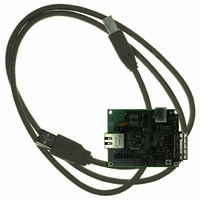KSZ8001L-EVAL Micrel Inc, KSZ8001L-EVAL Datasheet - Page 12

KSZ8001L-EVAL
Manufacturer Part Number
KSZ8001L-EVAL
Description
BOARD EVALUATION FOR KSZ8001L
Manufacturer
Micrel Inc
Datasheet
1.KSZ8001S.pdf
(46 pages)
Specifications of KSZ8001L-EVAL
Main Purpose
Interface, Ethernet PHY
Embedded
No
Utilized Ic / Part
KSZ8001L
Primary Attributes
Single Chip PHY, 100BASE-TX/100BASE-FX/10BASE-T
Secondary Attributes
MII, RMII, SMII, HP Auto MDI, MDI-X Auto Polarity Correction, LinkMD
Lead Free Status / RoHS Status
Lead free / RoHS Compliant
Other names
576-1620
Micrel
KSZ8001
Functional Description
100BASE-TX Transmit
The 100BASE-TX transmit function performs parallel-to-serial conversion, NRZ to NRZI conversion, MLT-3 encoding and
transmission. The circuitry starts with a parallel-to-serial conversion, which converts the 25 MHz, 4-bit nibbles into a 125 MHz serial
bit stream. The incoming data is clocked in at the positive edge of the TXC signal. The serialized data is further converted from
NRZ to NRZI format, and then transmitted in MLT3 current output. The output current is set by an external 1% 6.65 KΩ resistor for
the 1:1 transformer ratio. It has typical rise/fall times of 4 ns and complies with the ANSI TP-PMD standard regarding amplitude
balance, overshoot and timing jitter. The wave-shaped 10BASE-T output driver is also incorporated into the 100BASE-TX driver.
100BASE-TX Receive
The 100BASE-TX receive function performs adaptive equalization, DC restoration, MLT-3 to NRZI conversion, data and clock
recovery, NRZI to NRZ conversion, and serial-to-parallel conversion.
The receiving side starts with the equalization filter to
compensate for inter-symbol interference (ISI) over the twisted pair cable. Since the amplitude loss and phase distortion are a
function of the length of the cable, the equalizer has to adjust its characteristic to optimize performance. In this design, the variable
equalizer will make an initial estimation based upon comparisons of incoming signal strength against some known cable
characteristics, then tunes itself for optimization. This is an ongoing process and can self adjust against environmental changes
such as temperature variations.
The equalized signal then goes through a DC restoration and data conversion block.
The DC restoration circuit is used to
compensate for the effects of base line wander and to improve the dynamic range. The differential data conversion circuit converts
the MLT3 format back to NRZI. The slicing threshold is also adaptive.
The clock recovery circuit extracts the 125 MHz clock from the edges of the NRZI signal. This recovered clock is then used to
convert the NRZI signal into the NRZ format. Finally, the NRZ serial data is converted to 4-bit parallel 4B nibbles. A synchronized
25 MHz RXC is generated so that the 4B nibbles is clocked out at the negative edge of RCK25 and is valid for the receiver at the
positive edge. When no valid data is present, the clock recovery circuit is locked to the 25 MΗz reference clock and both TXC and
RXC clocks continue to run.
PLL Clock Synthesizer
The KSZ8001 generates 125 MΗz, 25 MΗz and 20 MΗz clocks for system timing. An internal crystal oscillator circuit provides the
reference clock for the synthesizer.
Scrambler/De-scrambler (100BASE-TX only)
The purpose of the scrambler is to spread the power spectrum of the signal in order to reduce EMI and baseline wander.
10BASE-T Transmit
When TXEN (transmit enable) goes high, data encoding and transmission will begin. The KSZ8001 will continue to encode and
transmit data as long as TXEN remains high. The data transmission will end when TXEN goes low. The last transition occurs at the
boundary of the bit cell if the last bit is zero, or at the center of the bit cell if the last bit is one. The output driver is incorporated into
the 100BASE- driver to allow transmission with the same magnetic. They are internally wave-shaped and pre-emphasized into
outputs with a typical 2.5 V amplitude. The harmonic contents are at least 27 dB below the fundamental when driven by an all-ones
Manchester-encoded signal.
10BASE-T Receive
On the receive side, input buffer and level detecting squelch circuits are employed. A differential input receiver circuit and a PLL
performs the decoding function. The Manchester-encoded data stream is separated into clock signal and NRZ data. A squelch
circuit rejects signals with levels less than 300 mV or with short pulse widths in order to prevent noises at the RX+ or RX- input from
falsely trigger the decoder. When the input exceeds the squelch limit, the PLL locks onto the incoming signal and the KSZ8001
decodes a data frame. This activates the carrier sense (CRS) ad RXDV signals and makes the receive data (RXD) available. The
receive clock is maintained active during idle periods in between data reception.
March 2006
Revision 1.03
12













